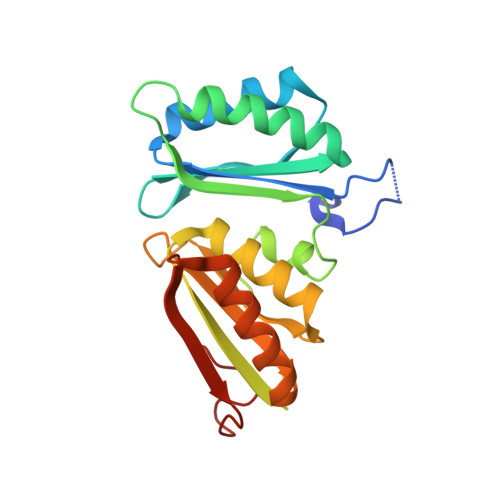Structure and Function of a Bacterial Microcompartment Shell Protein Engineered to Bind a [4Fe-4S] Cluster.
Aussignargues, C., Pandelia, M.E., Sutter, M., Plegaria, J.S., Zarzycki, J., Turmo, A., Huang, J., Ducat, D.C., Hegg, E.L., Gibney, B.R., Kerfeld, C.A.(2016) J Am Chem Soc 138: 5262-5270
- PubMed: 26704697
- DOI: https://doi.org/10.1021/jacs.5b11734
- Primary Citation of Related Structures:
5DIH, 5DII - PubMed Abstract:
Bacterial microcompartments (BMCs) are self-assembling organelles composed of a selectively permeable protein shell and encapsulated enzymes. They are considered promising templates for the engineering of designed bionanoreactors for biotechnology. In particular, encapsulation of oxidoreductive reactions requiring electron transfer between the lumen of the BMC and the cytosol relies on the ability to conduct electrons across the shell. We determined the crystal structure of a component protein of a synthetic BMC shell, which informed the rational design of a [4Fe-4S] cluster-binding site in its pore. We also solved the structure of the [4Fe-4S] cluster-bound, engineered protein to 1.8 Å resolution, providing the first structure of a BMC shell protein containing a metal center. The [4Fe-4S] cluster was characterized by optical and EPR spectroscopies; it has a reduction potential of -370 mV vs the standard hydrogen electrode (SHE) and is stable through redox cycling. This remarkable stability may be attributable to the hydrogen-bonding network provided by the main chain of the protein scaffold. The properties of the [4Fe-4S] cluster resemble those in low-potential bacterial ferredoxins, while its ligation to three cysteine residues is reminiscent of enzymes such as aconitase and radical S-adenosymethionine (SAM) enzymes. This engineered shell protein provides the foundation for conferring electron-transfer functionality to BMC shells.
Organizational Affiliation:
Department of Chemistry, The Pennsylvania State University , University Park, Pennsylvania 16802, United States.















